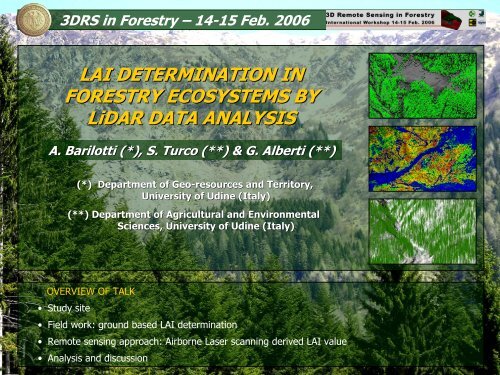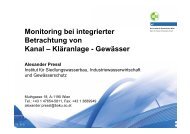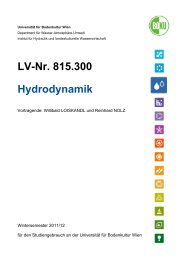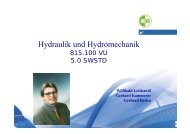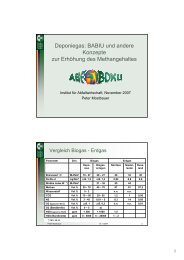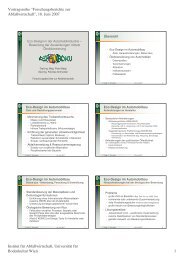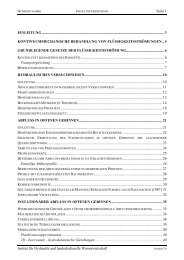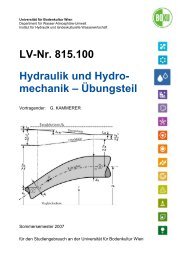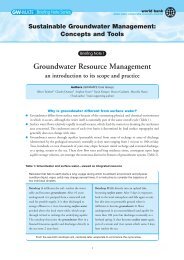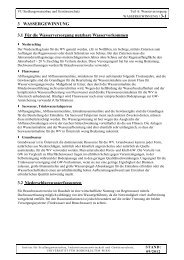LAI determination in forestry ecosystem by LiDAR data analysis
LAI determination in forestry ecosystem by LiDAR data analysis
LAI determination in forestry ecosystem by LiDAR data analysis
- No tags were found...
Create successful ePaper yourself
Turn your PDF publications into a flip-book with our unique Google optimized e-Paper software.
The study sitePramosioconiferous forest(spuce forest),Alpi Carniche:Lat: 46° 30’Long: 12° 55’Taipana broadleaved forest(beech forest);Prealpi Giulie:Lat: 46° 15’Long: 13° 05’-- Introduction - The <strong>data</strong> -Methodology -- Analysis -- Conclusions --
Laser scann<strong>in</strong>g <strong>data</strong>This work was carried out as part of theresearch activities supported <strong>by</strong> the INTERREGIIIA Italy-Slovenia 2003-2006 2006 project.METADATAPramosio(spruceforest)Taipana(beechforest)With <strong>LiDAR</strong> it is possible to carry out very highdensity survey of 3D po<strong>in</strong>ts of terra<strong>in</strong>, ofvegetation and much more…SurveyperiodSurvey areaLaser po<strong>in</strong>tdensityElevationrangeNumber ofstripOperativealtitude(aboveground)09/2003 07/200421 Km 2 16 Km 2~ 2 pt/m2 ~ 2 pt/m2564 - 2.093m435 - 1.140m11 10~ 1000 m ~ 1000 mScan angle ± 18° ± 18°Beamdivergence0,02 mrad 0,02 mrad-- Introduction - The <strong>data</strong> -Methodology -- Analysis -- Conclusions --
Ground based: sample plot21 Km 2transect_id area (m 2 ) forest_cat avg_ø (cm) avg_height (m) avg_crown_depth (m) n°trees/hectar <strong>LAI</strong>1 400 spruce 41 35 16 550 3,732 400 spruce 36 28 17 600 3,803 400 spruce 35 30 14 500 3,834 400 spruce-fir 40 32 16 400 4,605 400 spruce-fir 43 34 15 450 4,566 400 spruce-fir 35 32 12 700 4,417 400 spruce-fir 34 26 11 625 4,278 400 spruce-fir 34 27 9 700 4,719 400 spruce-fir 33 25 10 550 4,1310 400 spruce 33 26 8 950 4,1811 400 spruce 31 27 9 850 3,5412 400 spruce 27 26 10 1250 3,6413 10.000 spruce-fir na na na 625 4,3014 10.000 spruce na na na na 3,2115 1.000 beech 22 14 7 3830 5,7816 1.000 ash-mixed 15 15 11 1450 5,0017 400 ash-mixed 15 16 11 850 5,4218 400 beech 18 17 8 1525 5,6919 400 beech 26 28 22 775 5,4220 10.000 beech na na na na 5,4950 mtR316 Km 2R2MasterR1-- Introduction - The <strong>data</strong> -Methodology -- Analysis -- Conclusions --
<strong>LAI</strong> detection<strong>LAI</strong> = sum of the projected leaf surface persoil area<strong>LAI</strong> = s/Gwhere: s is the projected leaf area (m 2 )G is the ground area (m 2 )It is a dynamic parameter<strong>LAI</strong> varies with• species composition;• annual mean temperature;• vegetative period length;• plant age;• soil fertility;• season.Control boxIt is used to describe foreststructure, wood biomass andphotosynthesisLeaf area and biomass may beestimated us<strong>in</strong>g diffuse lightaccord<strong>in</strong>g to Beer’s law:I = I 0 e -k k Ldetectorsensorefiltrocampo di vistaspecchiolenti-- Introduction - The <strong>data</strong> -Methodology -- Analysis -- Conclusions --
Airborne laser scann<strong>in</strong>g<strong>LiDAR</strong> <strong>data</strong> were processed us<strong>in</strong>g Terrascansoftware ©Terrasolid, F<strong>in</strong>land. Ground po<strong>in</strong>tswere filtered <strong>by</strong> an automatic procedure(Axelsson, 2000).Vegetation po<strong>in</strong>ts were divided <strong>in</strong> two classes:- low vegetation (h ≤ 1 m above the ground);- high vegetation (h >1 m above the ground).g/v = 0.084 (spruce(forest)g/v = 0.035 (beech(forest)Indirect <strong>LAI</strong> measurements are based on solar lighttransmission or reflectance through vegetation.This can be assumed to be similar to the transmissionof the laser beam through the canopy.On the basis of this assumption, a Laser PenetrationIndex (LPI) was def<strong>in</strong>ed as follow:g ij = ground po<strong>in</strong>ts densityLPI ij = g ij / (g(ij + v ij )v ij = high vegetation po<strong>in</strong>ts density-- Introduction -- The <strong>data</strong> - Methodology - Analysis -- Conclusions --
<strong>LiDAR</strong> penetration <strong>in</strong>dex (LPI)g ijLPI ij= g ij/ (g ij+ v ij)• non-homogenous distribution of <strong>LiDAR</strong> sampl<strong>in</strong>gpo<strong>in</strong>ts <strong>in</strong> the areas studied;v ij5 m, appropriate for a 2 pts/m 2 sampl<strong>in</strong>g density.• g ij and v ij were assigned to each cell accord<strong>in</strong>g to aneighbourhood statistical <strong>analysis</strong> us<strong>in</strong>g a radius of• g ij <strong>in</strong> the denom<strong>in</strong>ator allows the normalization oflocal variations of the sampl<strong>in</strong>g density due to<strong>LiDAR</strong> strips overlapp<strong>in</strong>g and variation of thehelicopter speed.-- Introduction -- The <strong>data</strong> - Methodology - Analysis -- Conclusions --
<strong>LiDAR</strong> penetration <strong>in</strong>dex (LPI)g ijLPI ij= g ij/ (g ij+ v ij)• non-homogenous distribution of <strong>LiDAR</strong> sampl<strong>in</strong>gpo<strong>in</strong>ts <strong>in</strong> the areas studied;v ij5 m, appropriate for a 2 pts/m 2 sampl<strong>in</strong>g density.• g ij and v ij were assigned to each cell accord<strong>in</strong>g to aneighbourhood statistical <strong>analysis</strong> us<strong>in</strong>g a radius of• g ij <strong>in</strong> the denom<strong>in</strong>ator allows the normalization oflocal variations of the sampl<strong>in</strong>g density due to<strong>LiDAR</strong> strips overlapp<strong>in</strong>g and variation of thehelicopter speed.100 m-- Introduction -- The <strong>data</strong> - Methodology - Analysis -- Conclusions --
<strong>LiDAR</strong> penetration <strong>in</strong>dexLPI values close to 0 describe a dense vegetationwhile values close to 1 are characteristic of an openstand or a clear ground.Automatic classification forest – non forest areas100 m-- Introduction -- The <strong>data</strong> --Methodology - Analysis - Conclusions --
<strong>LiDAR</strong> penetration <strong>in</strong>dex<strong>LAI</strong> and LPI values for each plotTransect area m 2 forest_cat <strong>LAI</strong> mean_LPI1 400 spruce 3,73 0,162 400 spruce 3,8 0,133 400 spruce 3,83 0,134 400 spruce-fir 4,6 0,055 400 spruce-fir 4,56 0,066 400 spruce-fir 4,41 0,087 400 spruce-fir 4,27 0,078 400 spruce-fir 4,71 0,109 400 spruce-fir 4,13 0,1410 400 spruce 4,18 0,1411 400 spruce 3,54 0,1612 400 spruce 3,64 0,1513 10.000 spruce-fir 4,3 0,1314 10.000 spruce 3,21 0,1915 1.000 beech 5,78 0,0116 1.000 ash-mixed 5 0,0317 400 ash-mixed 5,42 0,0218 400 beech 5,69 0,0219 400 beech 5,42 0,0220 10.000 beech 5,49 0,02LPI values close to 0 describe a dense vegetationwhile values close to 1 are characteristic of an openstand or a clear ground.Automatic classification forest – non forest areas<strong>LAI</strong> = -12.86 * LPI + 5.59L<strong>in</strong>ear regression <strong>analysis</strong>7,006,005,00Broaded leaf foresty = -12,863x + 5,5919R 2 = 0,89<strong>LAI</strong>4,003,002,00Coniferous forest1,000,000 0,02 0,04 0,06 0,08 0,1 0,12 0,14 0,16 0,18 0,2mean LPI100 m-- Introduction -- The <strong>data</strong> --Methodology - Analysis - Conclusions --
Data <strong>analysis</strong>• A random re-sampl<strong>in</strong>g procedure of <strong>LiDAR</strong> <strong>data</strong> to estimate different laser po<strong>in</strong>ts densitieswas performed (from a density of 2 pts/m 2 to 1 pts/100 m 2 ).R 2 1,000,890,900,850,890,790,800,840,700,710,680,700,650,730,57 0,610,600,530,500,550,490,400,410,30Constant radius (5 m)0,20Variable radius0,260,27Polynomial <strong>in</strong>terpolation0,210,100,110,002 1 0,5 0,25 0,12 0,05 0,028 0,02 0,013 0,01Po<strong>in</strong>ts density (pts/m2)The pattern of correlation coefficient(R 2 ) between measured <strong>LAI</strong> and LPIcalculated on the basis ofneighbourhood <strong>analysis</strong> performedus<strong>in</strong>g a fixed radius (5 m) is reported<strong>in</strong> blue.In this case, R 2 decreases very fast <strong>by</strong>reduc<strong>in</strong>g laser po<strong>in</strong>ts density.To have a constant number of sampl<strong>in</strong>g po<strong>in</strong>ts, a variable radius for each re-sampl<strong>in</strong>g wasused apply<strong>in</strong>g the equation:r = (150/πρπρ) ½where r is <strong>in</strong> meters, ρ is the po<strong>in</strong>ts density (pts/m 2 ) and 150 is the number of po<strong>in</strong>ts with aradius of 5 m and a po<strong>in</strong>ts density of 2 pts/m 2 .-- Introduction -- The <strong>data</strong> --Methodology - Analysis - Conclusions --
Data <strong>analysis</strong>• The variation of R 2 for the correlation between LPI and <strong>LAI</strong> at different po<strong>in</strong>ts densities.7,007,007,006,00y = -12,863x + 5,5919R 2 = 0,896,00y = -10,927x + 5,5815R 2 = 0,856,00y = -9,4221x + 5,5271R 2 = 0,795,005,005,00<strong>LAI</strong>4,003,00<strong>LAI</strong>4,003,00<strong>LAI</strong>4,003,002,001,00LPI = 0.192,001,00LPI = 0.242,001,00LPI = 0.290,000 0,02 0,04 0,06 0,08 0,1 0,12 0,14 0,16 0,18 0,2mean LPI0,000,00 0,05 0,10 0,15 0,20 0,25 0,30mean LPI0,000,00 0,05 0,10 0,15 0,20 0,25 0,30 0,35mean LPI7,006,00y = -8,3121x + 5,4366R 2 = 0,707,006,00y = -7,5172x + 5,3531R 2 = 0,657,006,00y = -6,1567x + 5,3615R 2 = 0,685,005,005,00<strong>LAI</strong>4,003,00<strong>LAI</strong>4,003,00<strong>LAI</strong>4,003,002,001,00LPI = 0.332,001,00LPI = 0.382,001,00LPI = 0.450,000,00 0,05 0,10 0,15 0,20 0,25 0,30 0,35mean LPI0,000,00 0,05 0,10 0,15 0,20 0,25 0,30 0,35 0,40meanLPI0,000,00 0,05 0,10 0,15 0,20 0,25 0,30 0,35 0,40 0,45 0,50mean LPI7,006,005,00y = -5,5628x + 5,2786R 2 = 0,537,006,005,00y = -7,3055x + 5,6896R 2 = 0,717,006,005,00y = -7,2738x + 5,6629R 2 = 0,57<strong>LAI</strong>4,003,00<strong>LAI</strong>4,003,00<strong>LAI</strong>4,003,002,001,00LPI = 0.452,001,00LPI = 0.412,001,00LPI = 0.370,000,00 0,05 0,10 0,15 0,20 0,25 0,30 0,35 0,40 0,45 0,50mean LPI0,000,00 0,05 0,10 0,15 0,20 0,25 0,30 0,35 0,40 0,45mean LPI0,000,00 0,05 0,10 0,15 0,20 0,25 0,30 0,35 0,40mean LPI-- Introduction -- The <strong>data</strong> --Methodology - Analysis - Conclusions --
Data <strong>analysis</strong>Pts/m2 2 – 1 – 0.5 – 0.25 – 0.12 – 0.05 – 0.028 – 0.02 – 0.013 – 0.01The variation of the spatial values of Laser Penetration Index us<strong>in</strong>gdifferent sample density-- Introduction -- The <strong>data</strong> --Methodology - Analysis - Conclusions --
Conclusion• The significant l<strong>in</strong>ear correlationbetween field <strong>LAI</strong> values and LPI(R 2 =0.89, P
Thank you for yourattentionhttp://geomatica.uniud.ite.mail: : andrea.barilotti@uniud.it


